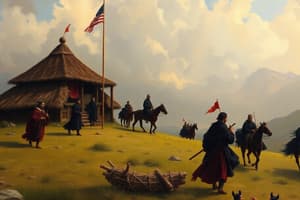Podcast
Questions and Answers
What happened to Mongolia after Genghis Khan's death in 1227?
What happened to Mongolia after Genghis Khan's death in 1227?
- It was divided into 4 sections called Counties
- It was divided into 4 sections called Khanates (correct)
- It remained united under Genghis Khan's successors
- It was divided into 4 sections called States
Why did the Mongols terrorize people?
Why did the Mongols terrorize people?
- The strong survived in Ancient Mongolia due to the harsh geography
- To make other people talk about them, and write about them in books
- They only terrorized people after they conquered them
- To spread fear, thus making them more likely to surrender without a fight (correct)
How do we know that diversity was an important part of the Mongol Empire (1200-1350)?
How do we know that diversity was an important part of the Mongol Empire (1200-1350)?
- They practiced psychological warfare
- The Mongol Empire ruled peoples from China, Russia, Eastern Europe, and India (correct)
- They conquered and slaughtered many men
- Besides China, Southeast Asia, Tibet, & Europe, they took over England for 200 years
What other place did the Mongols take over for the next 200 years besides China, Southeast Asia, Tibet, and Europe?
What other place did the Mongols take over for the next 200 years besides China, Southeast Asia, Tibet, and Europe?
Who were the Mongols?
Who were the Mongols?
Who forced the Mongols out of China after about 100 years?
Who forced the Mongols out of China after about 100 years?
Which region was the Mongol Empire larger than at its height?
Which region was the Mongol Empire larger than at its height?
Who led the Mongols in conquering much of Asia?
Who led the Mongols in conquering much of Asia?
What was the name given to the Mongol reign?
What was the name given to the Mongol reign?
What was Genghis Khan's greatest weapon as he conquered?
What was Genghis Khan's greatest weapon as he conquered?
Where were the Mongols first located?
Where were the Mongols first located?
Flashcards
Mongolia after 1227
Mongolia after 1227
After Genghis Khan's death in 1227, Mongolia was divided into 4 sections.
Why Mongols used terror
Why Mongols used terror
To spread fear. This made people more likely to surrender without a fight.
Diversity in Mongol Empire
Diversity in Mongol Empire
The Mongol Empire ruled peoples from China, Russia, Eastern Europe, and India.
Mongol rule in Russia
Mongol rule in Russia
Signup and view all the flashcards
Who were the Mongols?
Who were the Mongols?
Signup and view all the flashcards
Expulsion of Mongols
Expulsion of Mongols
Signup and view all the flashcards
Leader of Mongol Conquest
Leader of Mongol Conquest
Signup and view all the flashcards
Name of Mongol Reign
Name of Mongol Reign
Signup and view all the flashcards
Genghis Khan's weapon
Genghis Khan's weapon
Signup and view all the flashcards
Mongol origin
Mongol origin
Signup and view all the flashcards
Study Notes
The Mongol Empire
- After Genghis Khan's death in 1227, Mongolia was divided into 4 sections called Khanates.
- The Mongols terrorized people to spread fear, making them more likely to surrender without a fight.
- The harsh geography of the Steppes meant that only the strong survived in Ancient Mongolia.
Characteristics of the Mongol Empire
- The Mongol Empire ruled peoples from China, Russia, Eastern Europe, and India, making diversity an important part of the empire.
- They practiced psychological warfare and conquered many territories.
- They took over Russia and other places for the next 200 years.
Genghis Khan and Mongol Leaders
- Genghis Khan's real name was Temujin.
- Kublai Khan, a grandson of Genghis Khan, united with the Chinese to create the Yuan Dynasty.
- Genghis Khan led Mongols in conquering much of Asia.
- Ogedei Khan was known as the "Great Khan" and united the Mongol tribes into a powerful empire.
Geography and Expansion
- The Mongol Empire stretched across Europe and Asia.
- At its height, the Mongol Empire was larger than the size of China.
- Mongols tried to conquer Japan but were unsuccessful due to violent storms and defeat by the Japanese Army.
Notable Figures and Events
- Marco Polo visited the Mongol Empire and served as an ambassador for Kublai Khan.
- Kublai Khan overthrew the Song Dynasty to establish the Yuan Dynasty.
- The Mongol military units were composed of skilled horsemen, known as Legionaries.
Characteristics of the Mongol Empire
- The Mongol Empire relied on trade to make interactions with surrounding neighbors.
- Genghis Khan's greatest weapon as he conquered was the spread of terror.
- The Mongol Empire emerged from the unification of nomadic tribes in Mongolia.
Studying That Suits You
Use AI to generate personalized quizzes and flashcards to suit your learning preferences.



